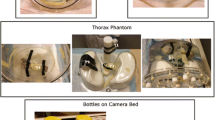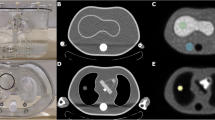Abstract.
Quantification in positron emission tomography (PET) and single photon emission tomographic (SPET) relies on attenuation correction which is generally obtained with an additional transmission measurement. Therefore, the evaluation of the radiation doses received by patients needs to include the contribution of transmission procedures in SPET (SPET-TM) and PET (PET-TM). In this work we have measured these doses for both PET-TM and SPET-TM. PET-TM was performed on an ECAT EXACT HR+ (CTI/Siemens) equipped with three rod sources of germanium-68 (380 MBq total) and extended septa. SPET-TM was performed on a DST (SMV) equipped with two collimated line sources of gadolinium-153 (4 GBq total). Two anthropomorphic phantoms representing a human head and a human torso, were used to estimate the doses absorbed in typical cardiac and brain transmission studies. Measurements were made with thermoluminescent dosimeters (TLDs, consisting of lithium fluoride) having characteristics suitable for dosimetry investigations in nuclear medicine. Sets of TLDs were placed inside small plastic bags and then attached to different organs of the phantoms (at least two TLDs were assigned to a given organ). Before and after irradiation the TLDs were placed in a 2.5-cm-thick lead container to prevent exposure from occasional sources. Ambient radiation was monitored and taken into account in calculations. Transmission scans were performed for more than 12 h in each case to decrease statistical noise fluctuations. The doses absorbed by each organ were calculated by averaging the values obtained for each corresponding TLD. These values were used to evaluate the effective dose (ED) following guidelines described in ICRP report number 60. The estimated ED values for cardiac acquisitions were 7.7×10–4±0.4×10–4 mSv/MBq · h and 1.9×10–6±0.4×10–6 ███/MBq · h for PET-TM and SPET-TM. respectively. For brain scans, the values of ED were calculated as 2.7×10–4±0.2×10–4 mSv/MBq · h for PET-TM and 5.2×10–7±2.3×10–7 mSv/MBq · h for SPET-TM. In our institution, PET-TM is usually performed for 15 min prior to emission. SPET-TM is performed simultaneously with emission and usually lasts 30 and 15 min for brain and cardiac acquisitions respectively. Under these conditions ED values, estimated for typical source activities at delivery time (22000 MBq in SPET and 555 MBq for PET), were 1.1×10–1± 0.1×10–1 mSv and 1.1×10–2±0.2×10–2 mSv for cardiac PET-TM and SPET-TM respectively. For brain acquisitions, the ED values obtained under the same conditions were 3.7×10–2±0.3×10–2 mSv and 5.8×10–3±2.6×10–3███ for PET-TM and SPET-TM respectively. These measurements show that the dose received by a patient during a transmission scan adds little to the typical dose received in a routine nuclear medicine procedure. Radiation dose, therefore, does not represent a limit to the generalised use of transmission measurements in clinical SPET or PET.
Similar content being viewed by others
Author information
Authors and Affiliations
Additional information
Received 12 May and in revised form 1 July 1998
Rights and permissions
About this article
Cite this article
Almeida, P., Bendriem, B., de Dreuille, O. et al. Dosimetry of transmission measurements in nuclear medicine: a study using anthropomorphic phantoms and thermoluminescent dosimeters. Eur J Nucl Med 25, 1435–1441 (1998). https://doi.org/10.1007/s002590050320
Issue Date:
DOI: https://doi.org/10.1007/s002590050320




